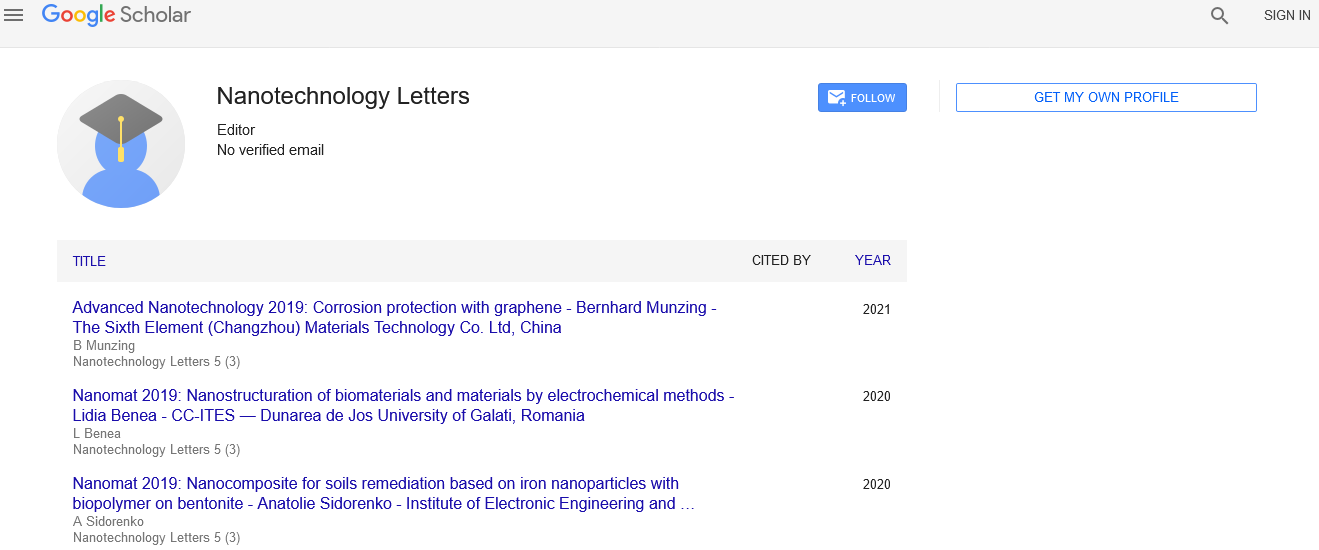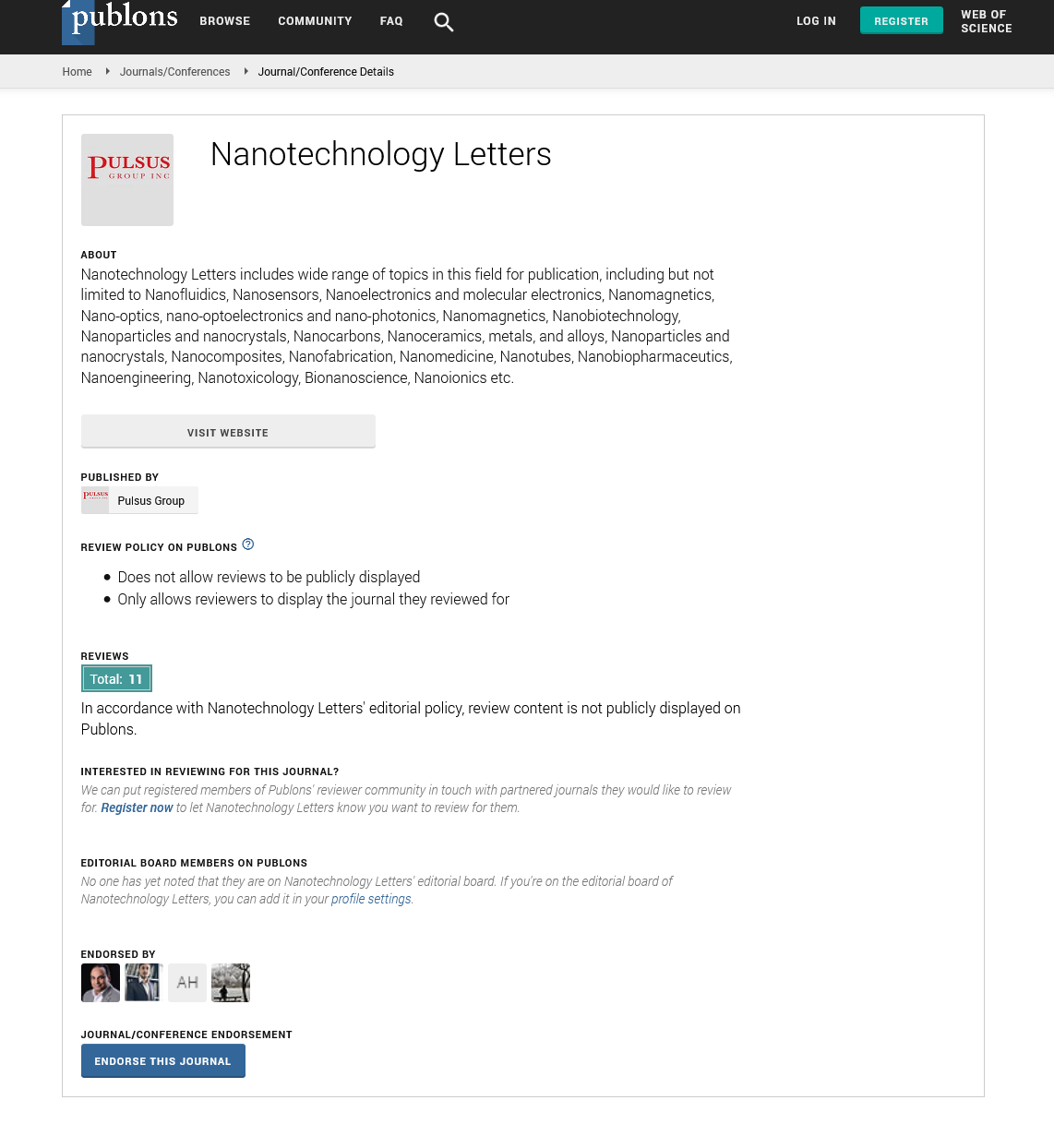Nanoparticle-based gene therapy
Received: 04-Mar-2022, Manuscript No. pulnl-22-4904; Editor assigned: 07-Mar-2022, Pre QC No. pulnl-22-4904(PQ); Reviewed: 22-Mar-2022 QC No. pulnl-22-4904(Q); Revised: 25-Mar-2022, Manuscript No. pulnl-22-4904(R); Published: 28-Mar-2022, DOI: 10.37532. pulnl.22.7.2.1-2.
Citation: Watson S. Nanoparticle-based gene therapy. Nanotechnol Lett. 2022; 7(2):1-2.
This open-access article is distributed under the terms of the Creative Commons Attribution Non-Commercial License (CC BY-NC) (http://creativecommons.org/licenses/by-nc/4.0/), which permits reuse, distribution and reproduction of the article, provided that the original work is properly cited and the reuse is restricted to noncommercial purposes. For commercial reuse, contact reprints@pulsus.com
Abstract
The composition and design of nanoparticles used for gene delivery are important factors in defining therapeutic half-life and biological effects. Polycation-based nanoparticle matrices are of particular interest due to their versatility and shown gene delivery efficacy. Because of their capacity to electrostatically bind oligonucleotides and compact them into nanostructures, these structures are frequently utilised as the matrix for gene delivery systems. The resultant colloidal nanoparticles can shield genetic material from destruction and enhance cellular entrance. In general, these nanoparticles influence gene expression by a system that comprises nanoparticle attachment to the cell surface, cellular absorption, intracellular entry, and oligonucleotide release.
Introduction
Therapeutic Deoxyribonucleic Acid (DNA) or Ribonucleic Acid (RNA) sequences have been delivered to cancer targets using nanoparticles made of artificial polymers, proteins, polysaccharides, and lipids. Surface modification or conjugation with biomolecules on the surface of nanoparticles has also improved the efficiency of cancer targeting. We present an overview of the most recent developments in nanoparticle-based targeted gene therapy for lung tumours in this review paper. To begin, we review traditional treatments and examine nanoparticle-based targeted gene therapy options. Second, we describe the most recent and representative studies in lung tumours, including malignant pleural mesothelioma, with a particular emphasis on the use of polymeric, lipid-based, and metal-based nanoparticles.
These genetic events in the complex process of cancer occurrence, such as activation of dominant oncogenes and inactivation of tumour suppressor genes, may present as novel targets for effective cancer treatments as researchers learn more about the genetic pathways involved in cancer development and progression. Gene therapy involves employing oligonucleotides to target and modulate aberrant genetic expressions in cancer cells that are linked to cancer formation. Gene therapy is believed to have a higher efficiency on cancer therapies and less systematic cytotoxicity in cancer patients as compared to traditional therapeutic procedures. The properties and characteristics of the particulate carriers, such as the materials, particle size, and surface charge, may influence the level of drug-loaded particle accumulation in tumour tissues. The neutral or negatively charged nanoparticles have stronger durability against enzymatic assaults and a longer circulation period in the bloodstream than the cationic nanoparticles; nevertheless, the cationic nanoparticles have higher cellular absorption due to the negative charges on cancer cells.
Active targeting, on the other hand, is based on the use of a molecular targeting agent to specifically target biomarkers or receptors on cancer cells. Active cancer targeting has been extensively researched and implemented in medication delivery systems to actively target tumour cells while reducing systemic toxicity. Nanoparticles have been used in lung cancer therapy to transfer gene molecules such as DNA, plasmid DNA (pDNA), messenger RNA (mRNA), small interfering RNA (siRNA), microRNA (miRNA), and RNA precursors. In the last two decades, the development of nanoparticles for the delivery of DNA or pDNA has been a hot topic in cancer research. Due to their high gene transfection and silencing effectiveness, current ongoing studies imply that targeted administration of short RNAs such as siRNA and miRNA is gaining traction in the field of cancer therapy.
Small RNA molecules are less stable and more easily destroyed by enzymes in the microenvironment than DNA molecules, with the exception of their smaller size, which is typically between 10 and 20 KDa. In non-dividing cells, it has been observed that RNA is more effective than DNA in lipid-mediated transport. Due to its rapid onset, shorter duration of expression, and increased effectiveness, the experimental results suggested that RNA delivery would be better suited for short-term transient gene expression. Furthermore, the study of the regulatory roles of mRNA and miRNA in the formation of lung tumours has sparked a lot of interest in small RNA delivery for cancer treatment. Dendrimers are three-dimensional macromolecules with a central core that serves as the root from which extremely branching, tree-like polymer chains grow in an orderly and symmetric pattern. Dendrimers have gained a lot of interest from a wide range of research areas, including medication and gene delivery, since the notion was first introduced in the late 1970s and early 1980s.
Dendrimers are rarely used in gene delivery for lung cancer. Taratula et al. used generation 5 PPI dendrimeric nanoparticles to form complexes with siRNA for intratumoral gene delivery in their recently published in-vivo gene delivery research for lung cancer.






